Ningishzida
Ningishzida (sum: 𒀭𒊩𒌆𒄑𒍣𒁕, dnin-g̃iš-zid-da) is a Mesopotamian deity of vegetation and the underworld. Thorkild Jacobsen translates Ningishzida as Sumerian for "lord of the good tree".[1]
| Ningishzida 𒀭𒊩𒌆𒄑𒍣𒁕 | |
|---|---|
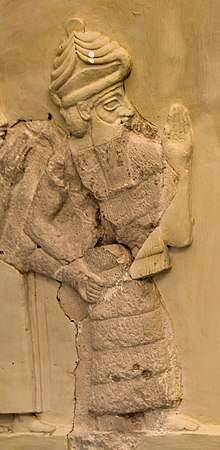 Ningishzida, with snakes emanating from his shoulders, on a relief of Gudea, circa 2000 BCE | |
| Symbol | Snake |
| Part of a series on |
| Ancient Mesopotamian religion |
|---|
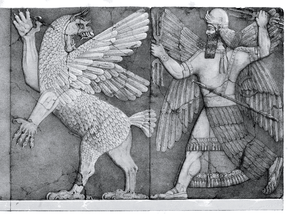 Chaos Monster and Sun God |
|
Seven gods who decree
|
|
Other major deities |
|
Demigods and heroes
|
| Related topics |
Mythology
In Sumerian mythology, he appears in Adapa's myth as one of the two guardians of Anu's celestial palace, alongside Dumuzi. He was sometimes depicted as a serpent with a human head.
Lagash had a temple dedicated to Ningishzida, and Gudea, patesi of Lagash in the 21st century BC (short chronology), was one of his devotees. In the Louvre, there is a famous green steatite vase carved for King Gudea of Lagash, dedicated by its inscription: "To the god Ningiszida, his god, Gudea, Ensi (governor) of Lagash, for the prolongation of his life, has dedicated this".
Ningishzida is sometimes the son of Ninazu and Ningiridda, even though the myth Ningishzida's journey to the netherworld suggests he is the son of Ereshkigal.[2] Following an inscription found at Lagash, he was the son of Anu, the heavens.[3]
His wife is Azimua[4] and also Geshtinanna,[5] while his sister is Amashilama. In some texts Ningishzida is said to be female,[6] which means "Nin" would then refer to Lady, which is mostly how the word is used by the Sumerians. He or she was one of the ancestors of Gilgamesh.
The Adapa myth mentions Ningishzida.[7]
The death of vegetation is associated with the travel to the underworld of Ningishzida.[7]
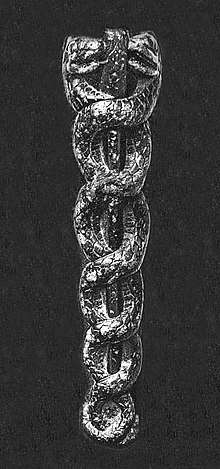 Serpent god Ningishzida on the libation vase of Gudea, circa 2100 BCE
Serpent god Ningishzida on the libation vase of Gudea, circa 2100 BCE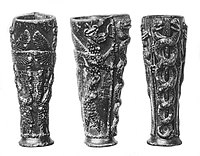 The "libation vase of Gudea" with the dragon Mušḫuššu, dedicated to Ningishzida (21st century BC short chronology). The caduceus (right) is interpreted as depicting the god himself. Inscription; ""To the god Ningiszida, his god, Gudea, Ensi (governor) of Lagash, for the prolongation of his life, has dedicated this"
The "libation vase of Gudea" with the dragon Mušḫuššu, dedicated to Ningishzida (21st century BC short chronology). The caduceus (right) is interpreted as depicting the god himself. Inscription; ""To the god Ningiszida, his god, Gudea, Ensi (governor) of Lagash, for the prolongation of his life, has dedicated this" Name of God Ningishzida, on a statue of Ur-Ningirsu.
Name of God Ningishzida, on a statue of Ur-Ningirsu.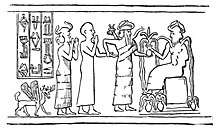 Seal of Gudea, led by Ningishzida, snakes emerging from his shoulders
Seal of Gudea, led by Ningishzida, snakes emerging from his shoulders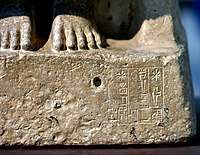 Detail, headless statue dedicated to the Sumerian deity Ningishzida, 2600-2370 BCE. Iraq Museum
Detail, headless statue dedicated to the Sumerian deity Ningishzida, 2600-2370 BCE. Iraq Museum
In popular culture
- The god appears in the Simon Necronomicon under the spelling "Ninnghizhidda".
- In Marilyn Manson's 1998 autobiography The Long Hard Road Out Of Hell, Manson encountered a suburban Occultist who pays tribute to Ningishzida.
- On Nile's Black Seeds of Vengeance album in the song 'Defiling The Gates Of Ishtar' there is an invocation to Ninnghizzhidda: 'Baad Angarru Ninnghizzhidda'
References
- Sumerian.org Q&A#20 (Ningishzida)
- Ningishzidda's journey to the netherworld on ETCSL
- Ira Maurice Price, Notes on the Pantheon of the Gudean Cylinders, The American Journal of Semitic Languages and Literatures, Vol. 17, No. 1 (Oct., 1900), pp. 47-53 JSTOR 528092
- Sumerian Mythology: Chapter II. Myths of Origins
- Stephen Bertman, 'Handbook to Life in Ancient Mesopotamia'. p. 123.
- Princeton University professors Arthur Frothingham and Allan Marquand, 'American journal of archaeology'. p. 189.
- Stone, Adam (2016). "Ningišzida (god)". Ancient Mesopotamian Gods and Goddesses, Oracc and the UK Higher Education Academy.
Further reading
- Michael Jordan, Encyclopedia of Gods, Kyle Cathie Limited, 2002
External links
| Wikimedia Commons has media related to Ningishzida. |